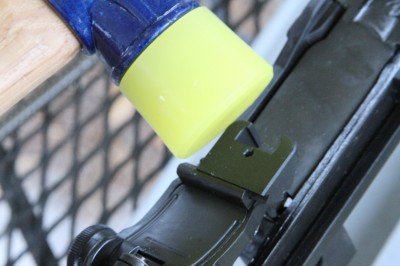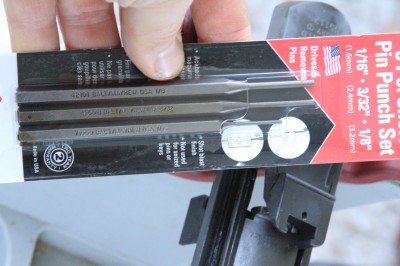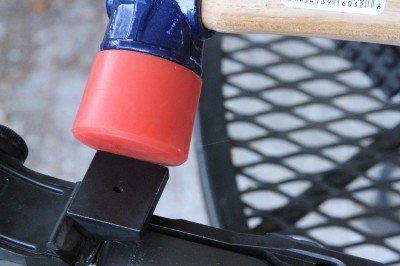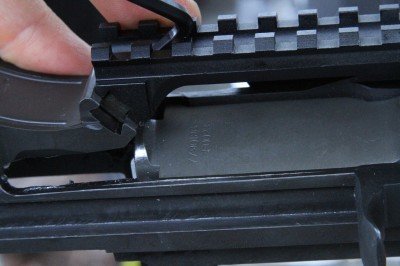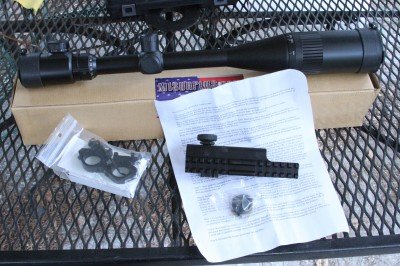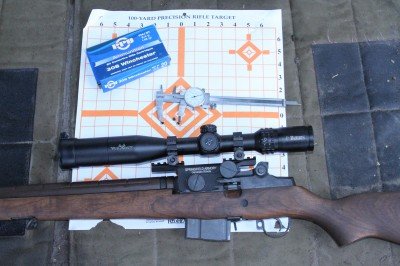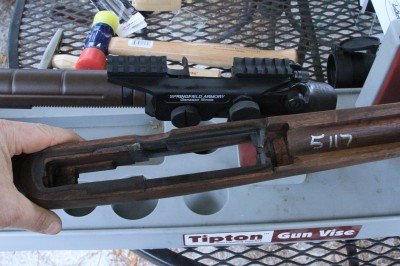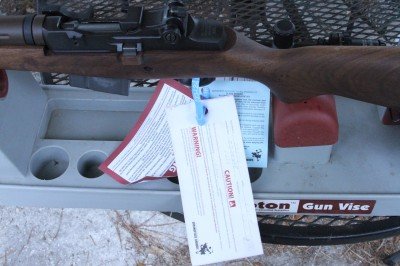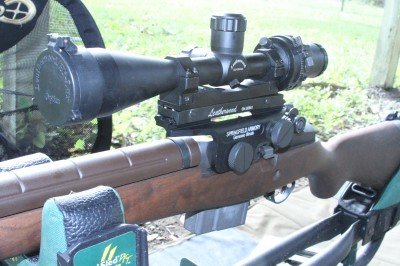
The M1A’s most classic scope is the Leatherwood, a copy of which we have recently reviewed. It is a cumbersome scope but really nifty, and not expensive right now.
Resources:
Springfield Armory M1A:
https://www.springfield-armory.com/m1a-series/
On GunsAmerica:
/Search.aspx?T=m1a
M1A Scope Mounts on Springfield Armory (30% off right now)
https://store.springfield-armory.com/shop/pc/Accessories-c57.htm
Cheap Copies On Amazon:
https://www.amazon.com/s/ref=nb_sb_noss_1?url=search-alias%3Daps&field-keywords=m1a+scope+mount
Burris Veracity on Optics Planet $599
https://www.opticsplanet.com/burris-2-10-42mm-riflescope.html
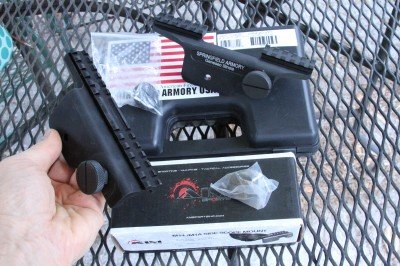
For this article we used the aluminum Springfield Armory branded mount as well as a couple exact copies, this one from AIM, as well as a UTG design.
With Christmas approaching, it is a great time to think about all of those upgrades to your guns you have been thinking about. One I have been considering for some time is putting a scope mount on my M1A, but my assumptions were that it was both expensive and difficult, requiring a gunsmith. Turns out I was wrong on both counts. There are expensive options and inexpensive options for installing a rear scope mount on the M1A, and they work equally as well. I tried both the official Springfield Armory mount, as well as a couple exact copies, as well as a new design from UTG. They all worked, and some better than others.
If you are new to shooting, the Springfield M1A is the semi-automatic equivalent of a the M14 rifle that originated in the Vietnam era. It shoots the .308 Winchester/7.62 NATO US cartridge, and is 2nd only to it’s older brother, the M1 Garand when it comes to “classic” battle rifles. The M14/M1A uses mostly the same action as a Garand, but it has a detachable magazine and fires the .308 instead of the .30-06. I now have three of these great rifles, and they have been featured here in the pages of GunsAmerica many a few times before. You may recognize the Archangel stock on one of my SOCOMs from one of those previous articles, and it is that rifle that I have been thinking about putting the rear mount on. With an adjustable stock, it is almost a shame to not have a scope on the rifle, and I don’t like the forward position long eye relief “Scout” scopes that are used on that forward mount of the SOCOM. For this article I also asked Springfield to send me one of their National Match rifles, so I could show you guys just how good they are with a scope attached.
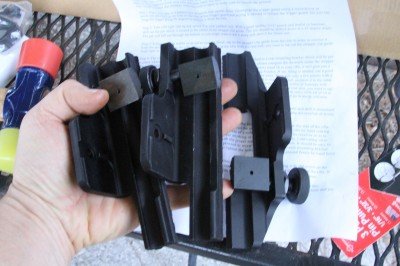
The AIM mount, the mount that came with the 10-50x scope, and the Springfield are mostly the same, except the Springfield has a split rail.
Fortunately, the M14/M1A receiver was created specifically for a scope mount. In fact there are many M14s still in service today overseas as sniper and designated marksman rifles, because the scope mount is so well done. Springfield Armory sells this mount direct to consumer from their website, and as I write this, the aluminum version is on sale for $86 and the steel one for $209. I purchased the aluminum one for $125 a few weeks ago, along with a couple of copies. To date I have not tried the steel one, but it seems to be an updated design that works more like the UTG mount I was able to test.
Snooping around on Amazon I discovered that the Springfield mount, which is more like the US Military mount, has been copied. You basically can buy the same mount for like $20, with free shipping on Prime. So much for spending $125 on it, but is a small difference between the Springfield mount and the $20 mount. On the Springfield mount there is a space between rail sections and the $20 mount has one solid rail. I didn’t have any issues with ejection using either mount, so I don’t know if it is functional or ascetic.
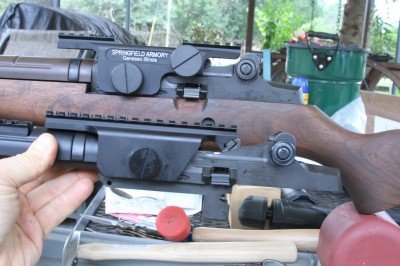
The bottom picture here is the UTG mount and the top one is the Springfield. They mount slightly different and the UTG is much lower, and lacks an easy on-off as well as specific windage adjustment.
I also found the same mount, without the AIM packaging, sold together with a 10-50x scope for $140, and that deal is still on Amazon. So I bought that too, figuring that I would show you guys what you get, if it was worth showing. It is worth showing, and the mount is the exact mount, but the scope rings are chinsy and only have one screw per side. You’ll see pictures of the scope and the mount on my SOCOM here, and I may just get new rings and leave that scope on that rifle. The SOCOM is a handy little sniper rifle.
The only mount I wouldn’t suggest is the UTG. It mounts a little differently than the standard US mount, and I don’t care for it. On the standard mount there is a thumbwheel that is designated just for windage adjustment of the mount itself. Look in the pictures and you’ll see, that you adjust the screw on the side of the mount to swivel the mount into alignment. This makes the mount not only idiot proof, but also very easy to take off and put back on, without losing your zero. The UTG mount works, don’t get me wrong, but the windage alignment is made by drifting the mounting bracket back and forth, then locking it into position with a set screw. That means that you have to leave the mount on if you want to maintain zero. There is nothing wrong with the UTG mount if you always want to case your rifle with the scope. I don’t.
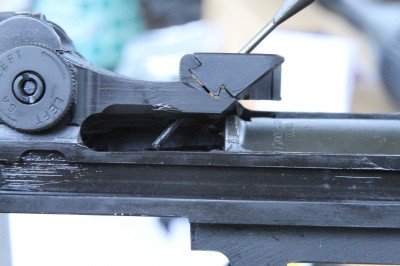
This is the dovetail that holes the stripper clip guide on the M1A. As you can see, I am pushing the lock pin out with a 3/32 punch.
One other note on the UTG mount is that it is also about a 1/2 inch lower than the standard style mount. Both the UTG and standard mount allow you to see the M1A open peep sights (which is really cool), but the UTG does it with a channel in the rail instead of raising the rail above the sights. I like the lowest profile I can get on a scope so I used low mounts with the bell of that cheap 10-50 scope hanging over the front of the UTG mount on my first test, and not only did the scope block the open sights, I also couldn’t get the scope to zero because the highest position of adjustment was still a foot high on the target at 100 yards. The bore axis of the M1A I think is just made for the higher mount, so it is probably best to position the scope at that height regardless of which mount you use. As I said above, it appears that the new “4th Gen” steel mount from Springfield uses the same mounting approach as the cheap UTG mount, so the design can’t be all that bad. I did notice on Amazon that the UTG mount has terrible reviews, and it could be for the reasons I’ve outlined to some degree.
Now I’d like to back up a minute and explain how the scope mounts work on an M1A. It can be a little intimidating if you are not a tinkerer. You probably already know what a “dovetail” is. Most front sights on pistols and many rear sights use a dovetail to hold to the gun. It is basically a wedge that you bang in from the side, and it just holds. The M1A uses a dovetail to keep on the stripper clip guide at the rear of the action. If you don’t use stripper clips you don’t need it, and because the gun is fed from a detachable magazine, most people figure that the stripper clip guide is superfluous and not required. When you take it off, that dovetail is a great solid connection for the scope mount, and you don’t need a gunsmith to do the swap.
Go to Home Depot or Walmart and buy a punch set. They are usually $8-$20. You need a 3/32nths punch. Also buy a plastic coated hammer, and maybe a small steel peening hammer. All of this shouldn’t set you back more than $40 and you’ll have them. The punch is used to remove the spring pin that is holding the stripper guide on. Take down the rifle by taking out the trigger guard, and remove the recoil spring from the op rod (on an M1A there is a little bar you have to push to the side). Look under the action and you’ll see the exit hole for that spring pin. Carefully use the 3/32 punch to drive out that pin. Then knock the stripper clip guide out with your plastic coated hammer. The block from the scope mount slides into the dovetail, and except for the UTG, it doesn’t go in easy. Don’t be shy. Use the plastic coated hammer and knock it in until you see the hole for the pin line up. Then use your peening hammer and punch to replace the pin in the new block.
That’s it! The mount attaches with two thumbwheels. The only trick is that you do have to adjust the windage on the mount to match the axis of the scope. I freaked out at first because My bullets were hitting 3 feet to the right of the target, but then I realized how the mount works. See the pictures if this sounds confusing. It isn’t.
As a real battle rifle, you wouldn’t think that the M1A is capable of good accuracy, but it is not uncommon to find match guns that come in under 1 MOA, or “Minute of Angle.” That means that in the absence of human error, the rifle is capable of keeping shots into about a 1″ circle at 100 yards. I shot my test National Match gun into just under 1.5 MOA with Hornady 168 grain factory ammo. To get into the 1 MOA range you generally will need custom hand loads in these guns, and there are plenty of “pet loads” out there in discussion forums to start with if you want to compete in the M1A tournaments, which are generally out to 600 yards off hand (ouch). I shot these groups from a Caldwell Lead Sled, as you can see in the pictures.
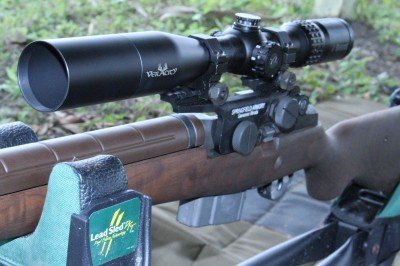
I settled on this first focal plane Burris Veracity 2-10x to leave on the gun. It is a ton of scope for the money.
There are three different scopes in these pictures. One is the current copy of the Vietnam era Leatherwood scope, which was actually created for the M14. It is a unique design that uses a cam system to adjust the scope for rangefinding and elevation. Please see our article on this scope for more information. I of course also tested the 10-50 scope that came in the Amazon package. I have tested about a dozen of these scopes under various brand names, and they work great for the money. 10x power on the lowest setting isn’t a big deal on the M1A because you can still see and zero the open sights, and that 40x really reaches out there. On this particular scope the reticle is listed as “range finding” but there were no instruction as to how to use the bars and dots inside the view. This is a standard second focal plane scope, so the rangefinding would only work at one power, usually the highest.
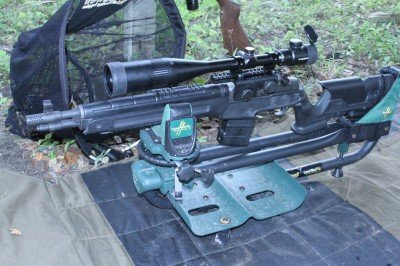
This is the 10-50x cheapo scope from Amazon that came with the mount for $140. Good buy? YES! Great tool for the job? Maybe with better scope rings. This is the Archangel stock which you will find in our archive.
The scope I settled on for the National Match, and one I will probably leave on the gun, is a Burris Veracity 2-10x. This is a 30mm tube scope with the reticle on the first focal plane. I have an article in the works on these amazing scopes, but in a nutshell, a first focal plane scope doesn’t work like the standard rifle scope you are currently used to. As you increase magnification on an FFP scope, the reticle gets smaller and bigger, with the target. So as you adjust the magnification, you go from a big reticle on a close image to a small reticle on a far image. This makes it so the elevation lines always match up to certain distances, no matter where the scope is adjusted. If you haven’t tried an FFP scope, try one they are awesome. Optics Planet has this Veracity for $599 right now, and there are a few other magnifications for a little more. This scope has caps on the adjustment knobs, so it is more for using the M1A as a flat shooting sniper rifle than for long range competition. The FFP competition scope from Burris is the XTR II, which we’ll be using for the upcoming FFP article as well.
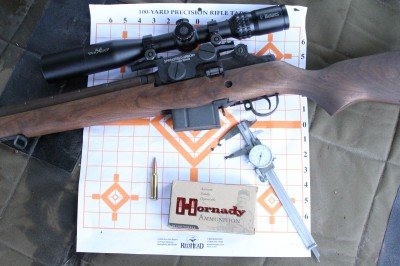
I tested for accuracy with a couple different types of ammo. I could shoot this Hornady 168 grain Match .308 into just under 1.5 MOA reliably and repeatably.
Getting back to the gun, please look through the pictures below for my two M1A scope mount projects. The SOCOM is going to be a work in progress I think. I may get some beefier rings for that 10-50x and see if I like it on the gun. The SOCOM is not the most accurate of the M1As, so I will have to see just how well I can make it shoot. It is quite a handy little sniper rifle, and in South Florida, there aren’t many tactical situations that are going to take you out much more than 200 yards. I love bolt action sniper rifles, but for the SHTF situation that might be headed our way, the M1A is a much more effective weapon for multiple assailants. And while I love the original look and feel, and the accuracy (!!) of the National Match, there is something about that handy little SOCOM that tells me it is a better goto rifle if the chips are down.
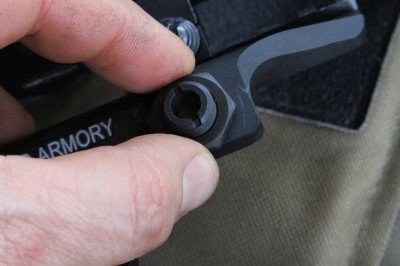
Trick to the miltary/standard/Springfield mount is that rear thumbwheel. When you take it off, you can adjust the windage on the mount with the underlying collar.
The M1A is one of those guns that will eventually make it into your safe if you are a shooting enthusiast (people give me crap when I say gun nut GUN NUT GUN NUT GUN NUT). The question is just which one it will be, or more likely, which ones. Until now I had never ventured down the scope mount path for my M1As, but I’ll most likely be buying this National Match from Springfield, and I don’t think either of these guns will ever have their stripper clip guide reinstalled.
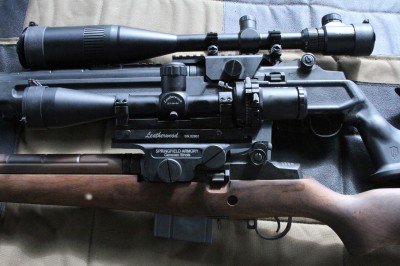
I initially tested the SOCOM with the UTG mount. It wasn’t within the elevation adjustment to zero the scope at 100 yards. The mount is very low and I used low profile rings. You would have to put the scope higher.
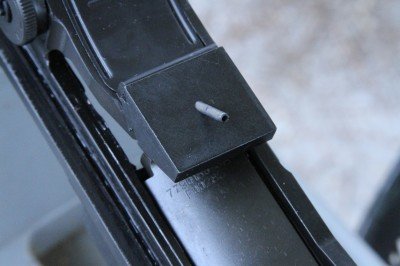
Mounting the block and not messing up the pin is probably the hardest thing, but just go slow and be careful. I light peening hammer helps.
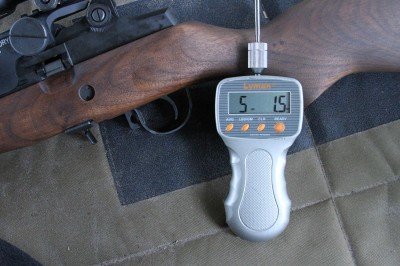
The National Match trigger is very light and crisp, but it has a little bit of takeup which gives me the willys shooting at long range. One of the few things I don’t like about the M1A
